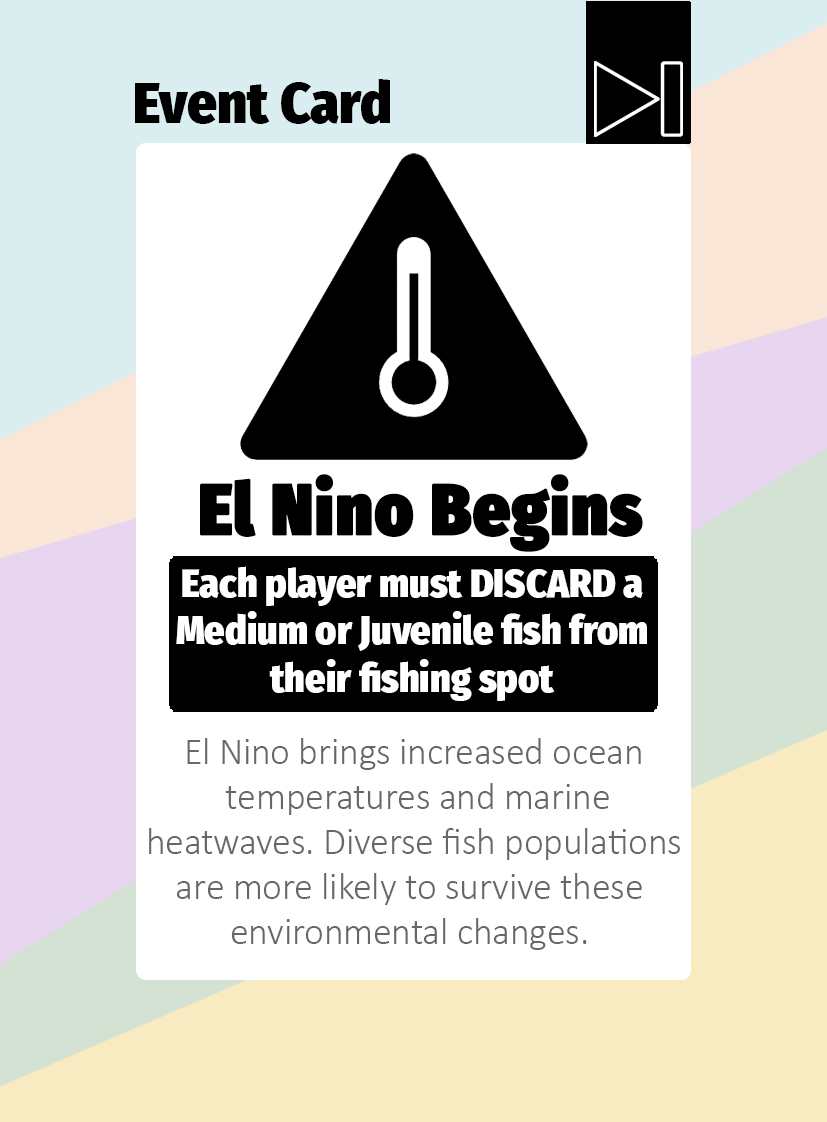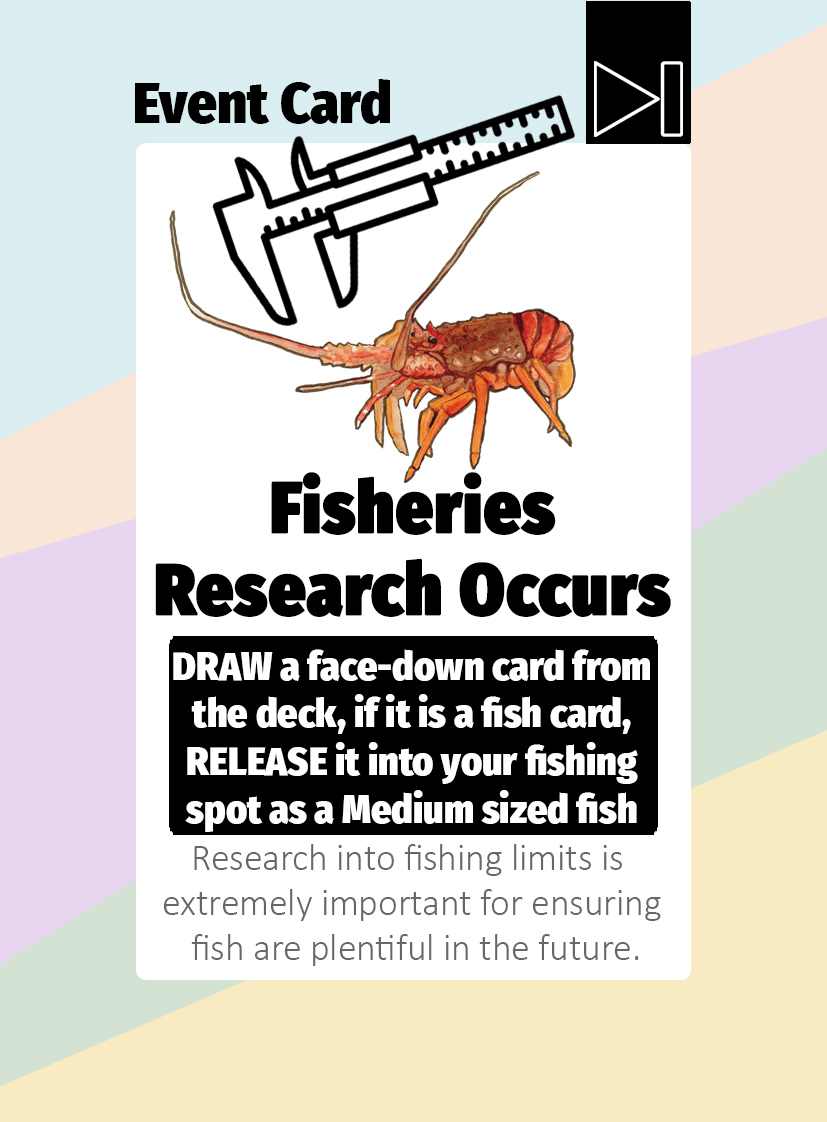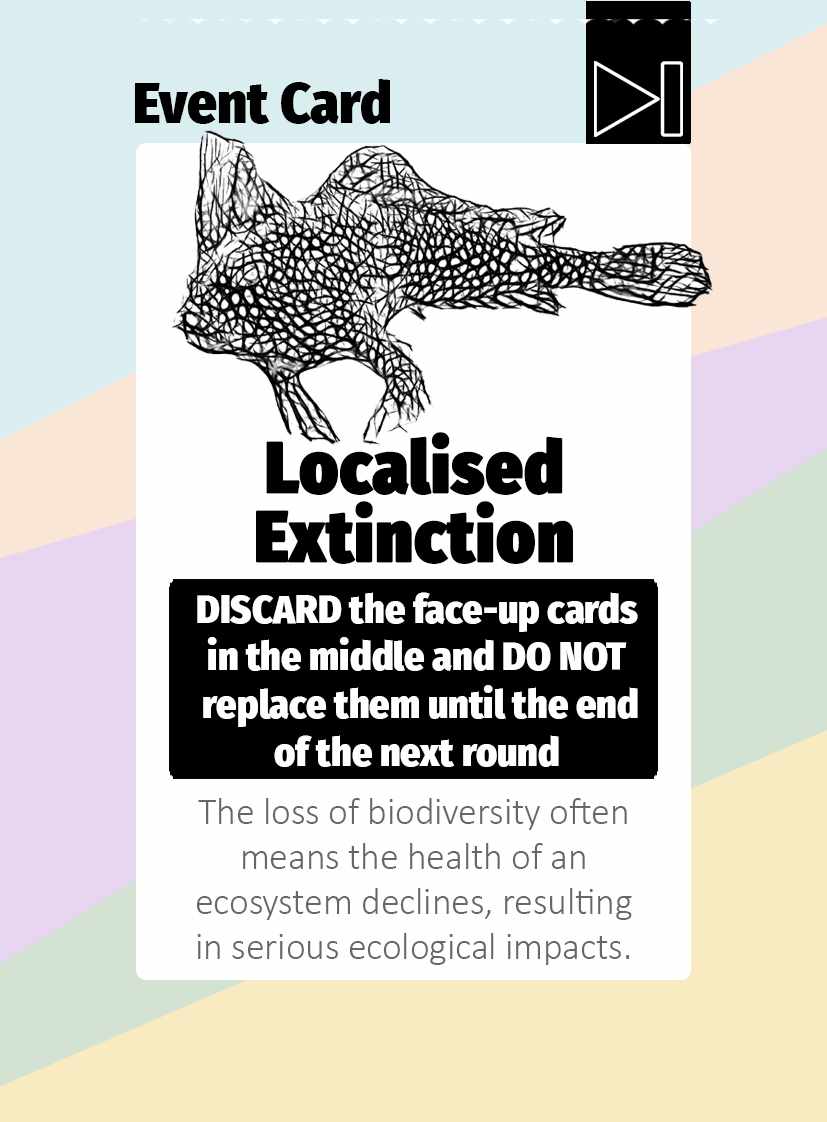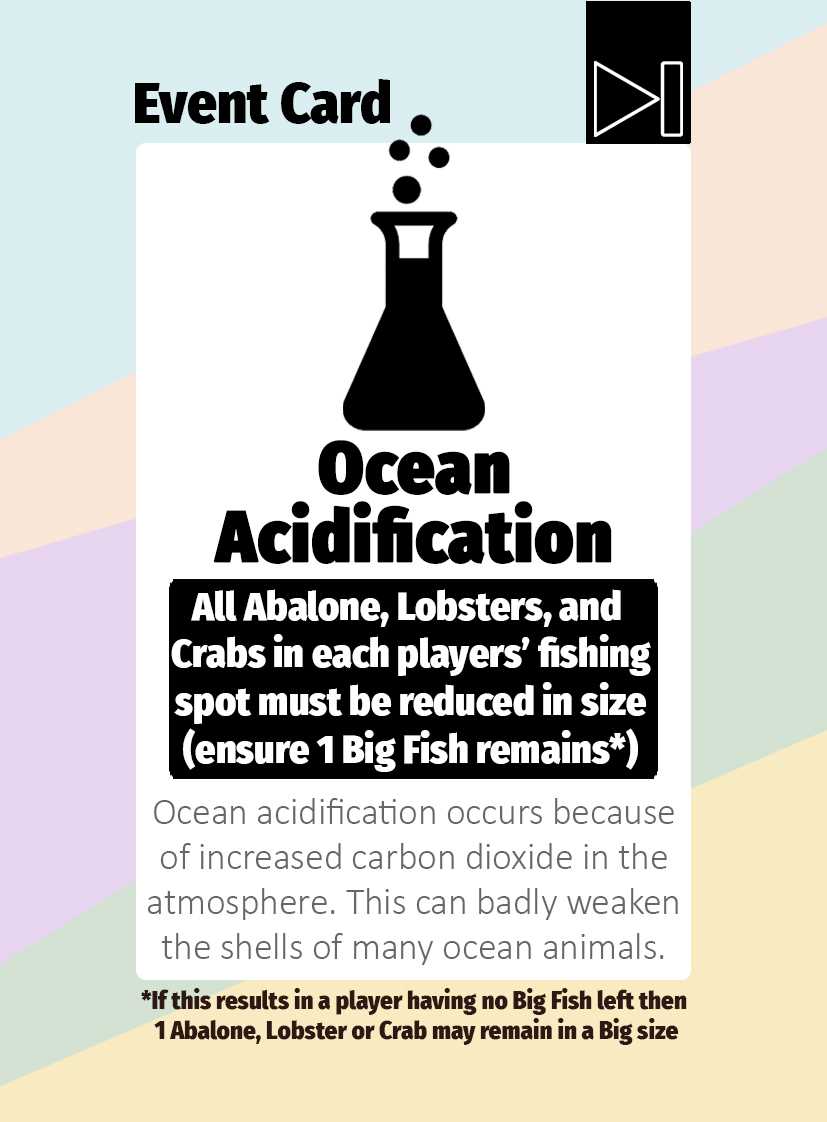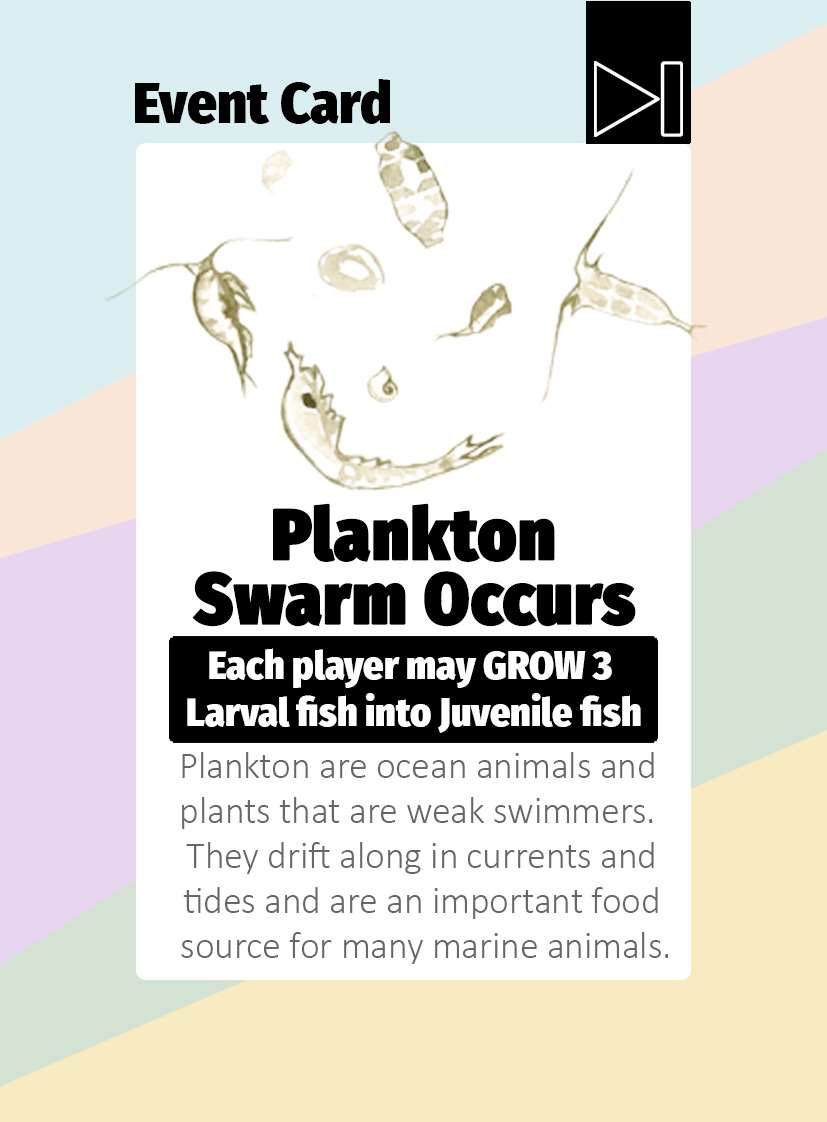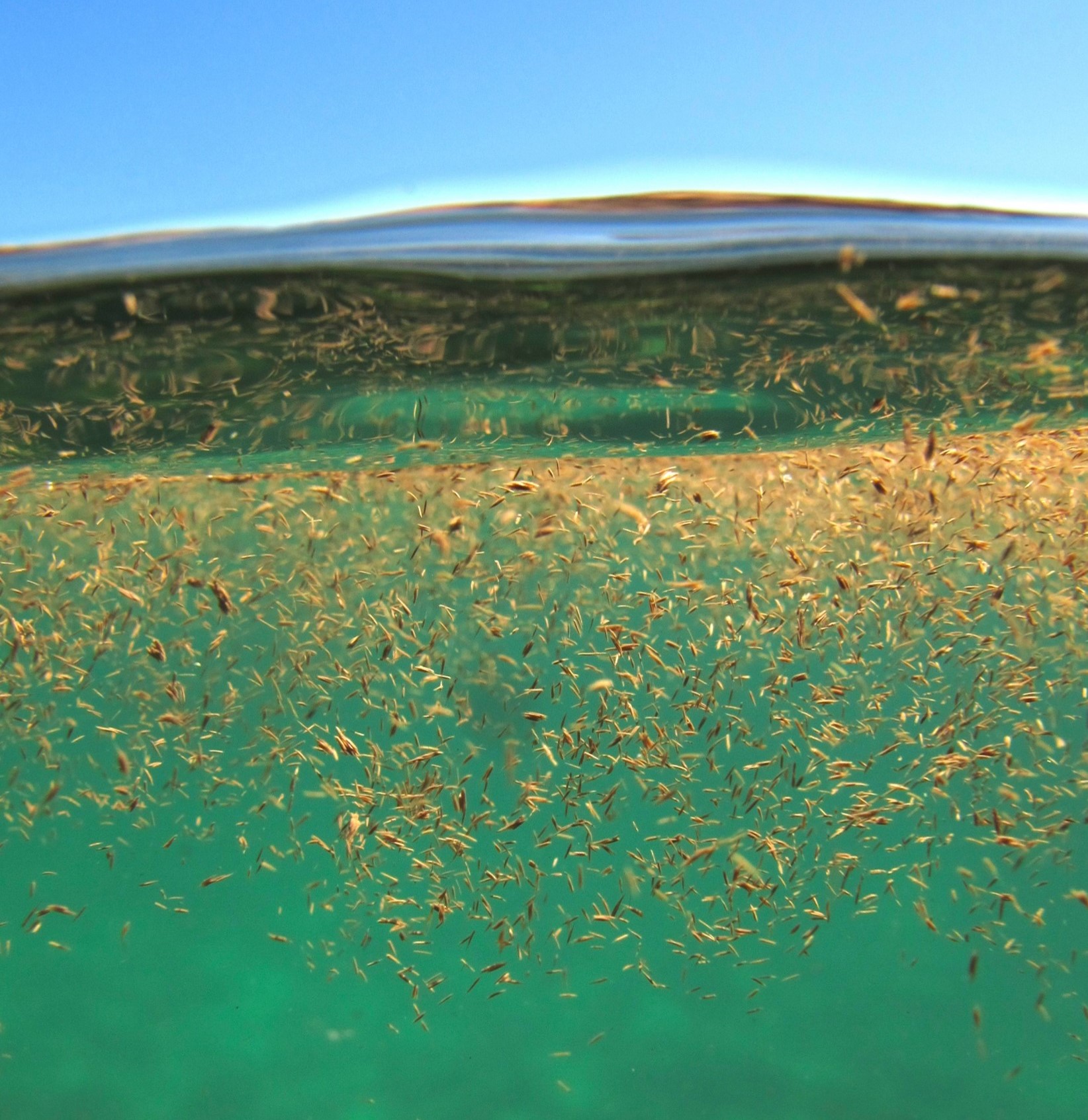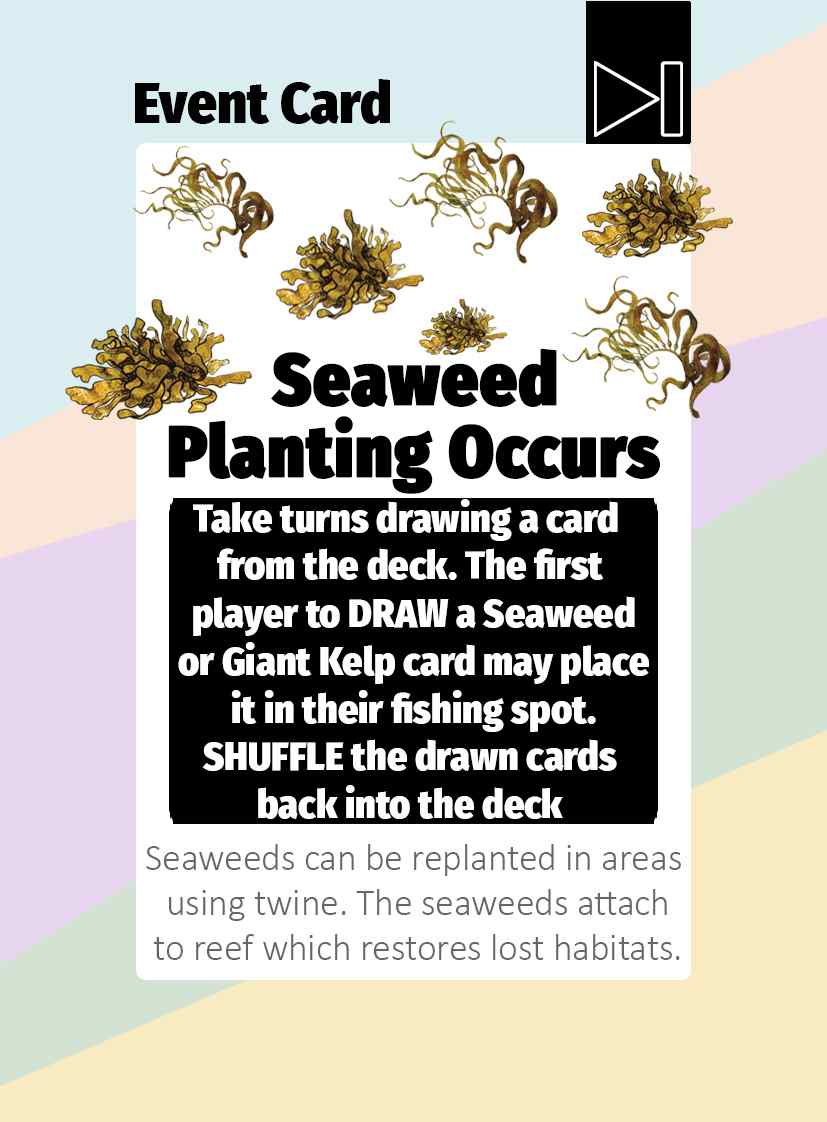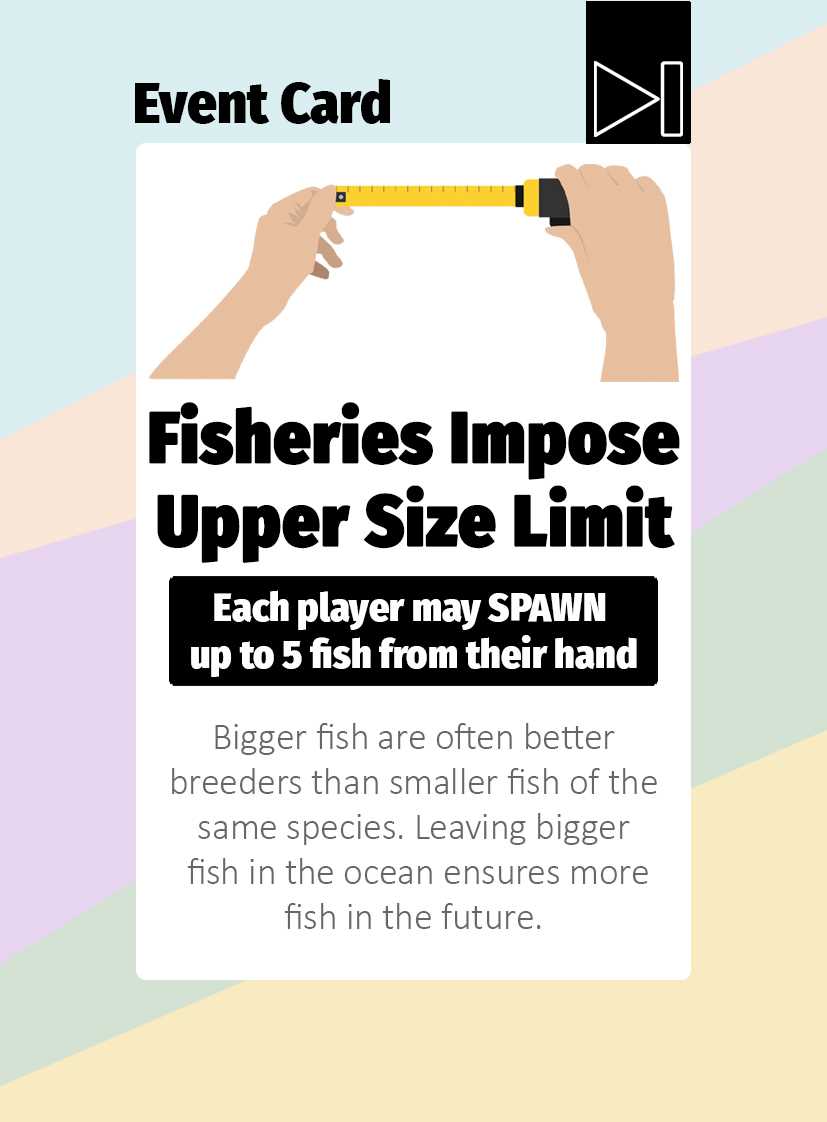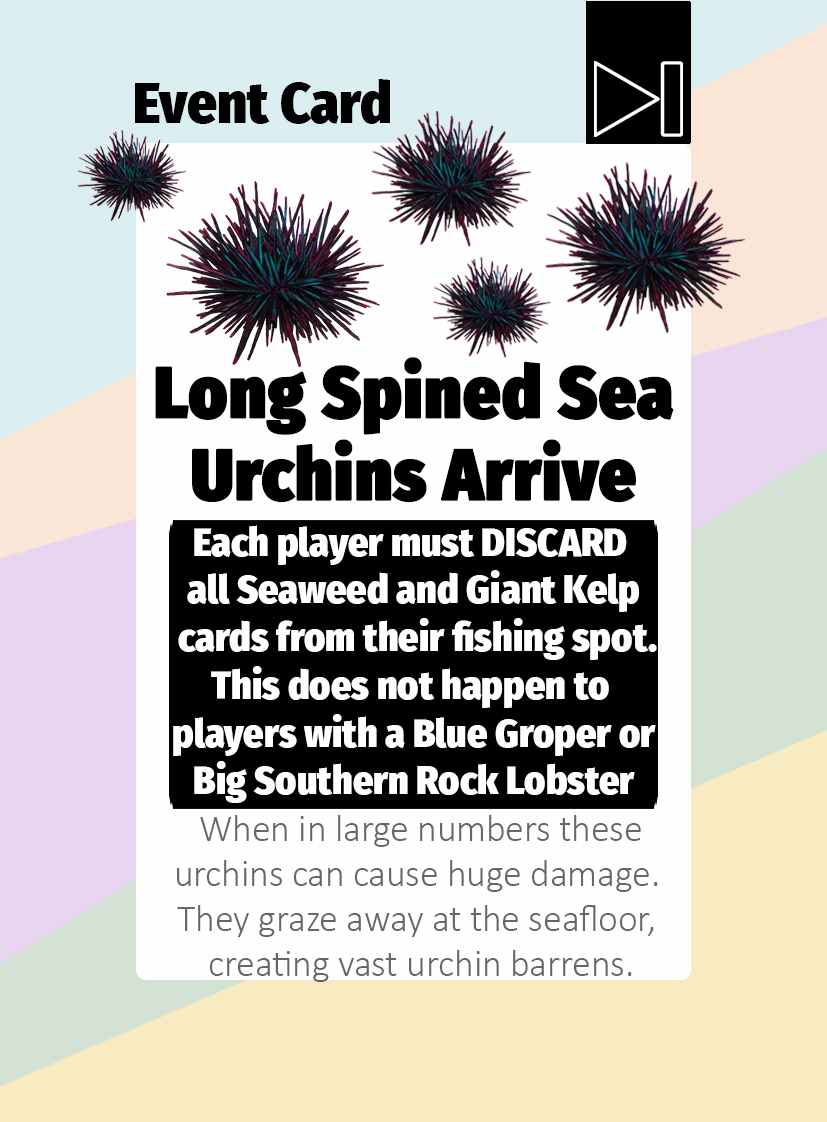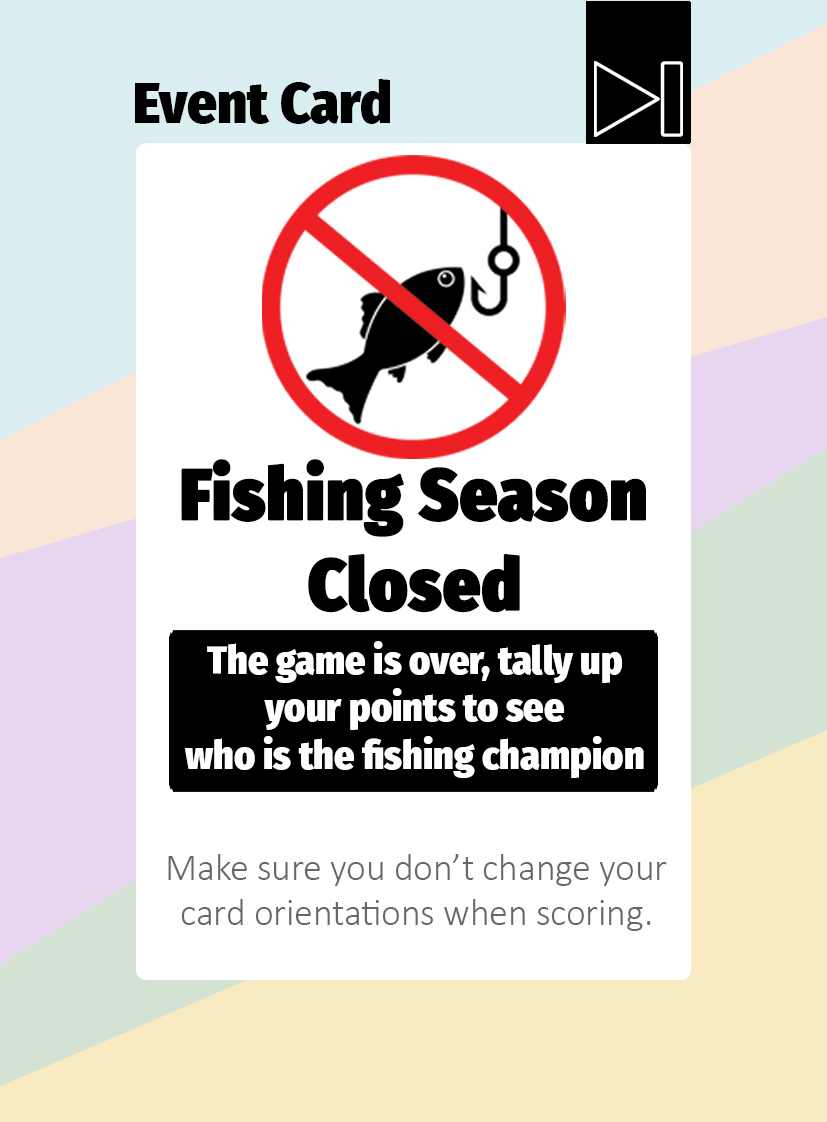Event cards
On this page you can learn more about the science behind all the round-end cards included in the game. You can find the science behind all the wildcards here.
We are constantly updating this page, so please visit regularly for new information. If you think we are missing some important information or important events or cards, please contact us!
A diver explores a collection of sponges and corals at one of the Reef Life Survey sites.
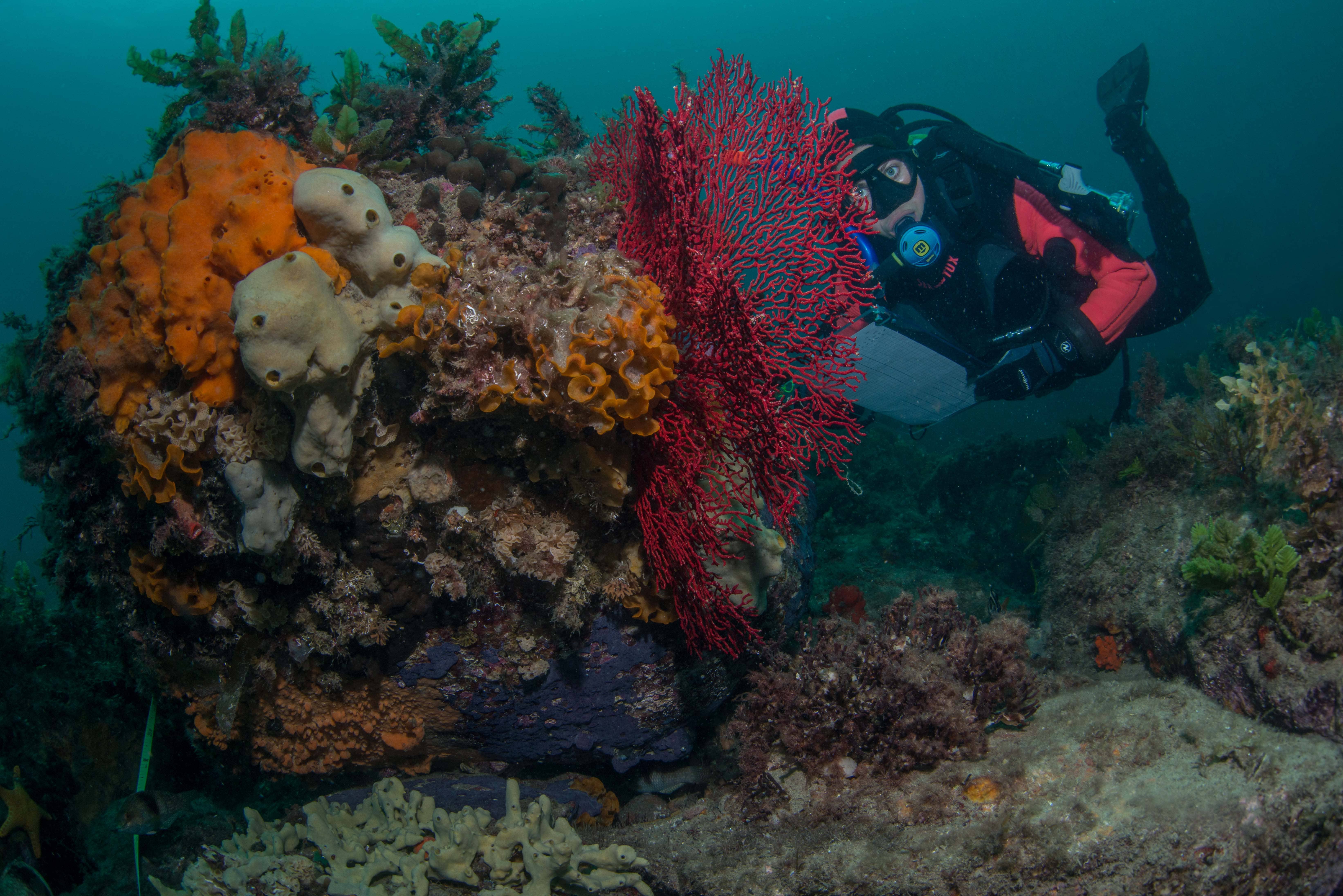
El Niño begins
When an El Niño is present on the south east coast of Australia more heatwaves, strong swells and storms affect the ocean. Increases in sea surface temperature can also occur. This can mean smaller individuals of a species are less likely to be able to survive these events. Species such as Abalone have also been observed as having decreased reproductive ability as heatwaves and severe weather cause physiological stress. There is also evidence that fish move away from certain coastal areas, meaning fishing ability is potentially changed in El Niño years.
Learn more
- See this Cosmos article for an explanation of El Niño and La Niña climate patterns
- The California Department of Fish & Wilflife has some great information on howEl Niño affect natural wildlife populations
- See this ARC site for an explanation of how El Niño affects Australia’s weather
- Increases in marine heatwaves due to El Niño conditions have also affected abalone and other important invertebrates in Australia
Fisheries research occurs
Fisheries have collapsed in the past, and species have been overcaught to the verge of extinction. This can come as a surprise – there may still be fish being caught, and the fish may appear to be plentiful. In reality we are just getting better at catching them, or the remaining population can reach a critical point beyond which recovery is challenging without intervention. For instance, if most of the breeding population has been fished and the remaining population is being fished too fast, then the individuals left don’t have a chance to reproduce.
This is more likely with fish that mature at an old age, such as orange roughy that need to survive 27-32 years before they can reproduce. In the 1980s and 1990s orange roughy were being harvested by fisheries so fast that the fishery collapsed (it was no longer economically viable to harvest these fish as too few were being caught each trip). Without baseline information on how a population is structured in terms of age, size and genetics, we are unable to determine how the population is responding to harvesting by people. With this information however, managers can intervene to save a species and ensure sustainable harvesting into the future.
Learn more
- Learn why orange roughy is so vulnerable to overfishing here
- Information on current orange roughy monitoring can be found here and this article shows how the species is now beginning to come back in Tasmania
A diver being handed a stereo-video system. The diver will swim transects, and all fish observed will be counted and measured to get baseline information on species abundance and body size. Photo: A.R. Coghlan.
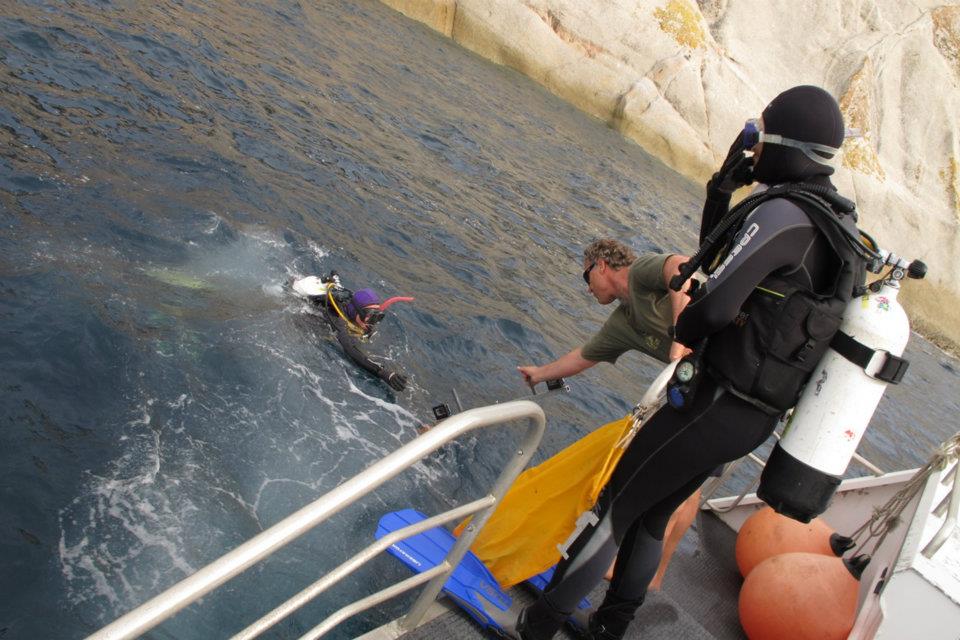
Localised species extinction
Biodiversity loss (a decline in the number of species present in an ecosystem) is known to cause the ocean ecosystem to weaken in its ability to adapt and withstand changes. These changes include events such as marine heatwaves, climate change and weather patterns. An ecosystem with lower biodiversity is much more likely to suffer severe negative effects than a more biodiverse and resilient ocean ecosystem.
Learn more
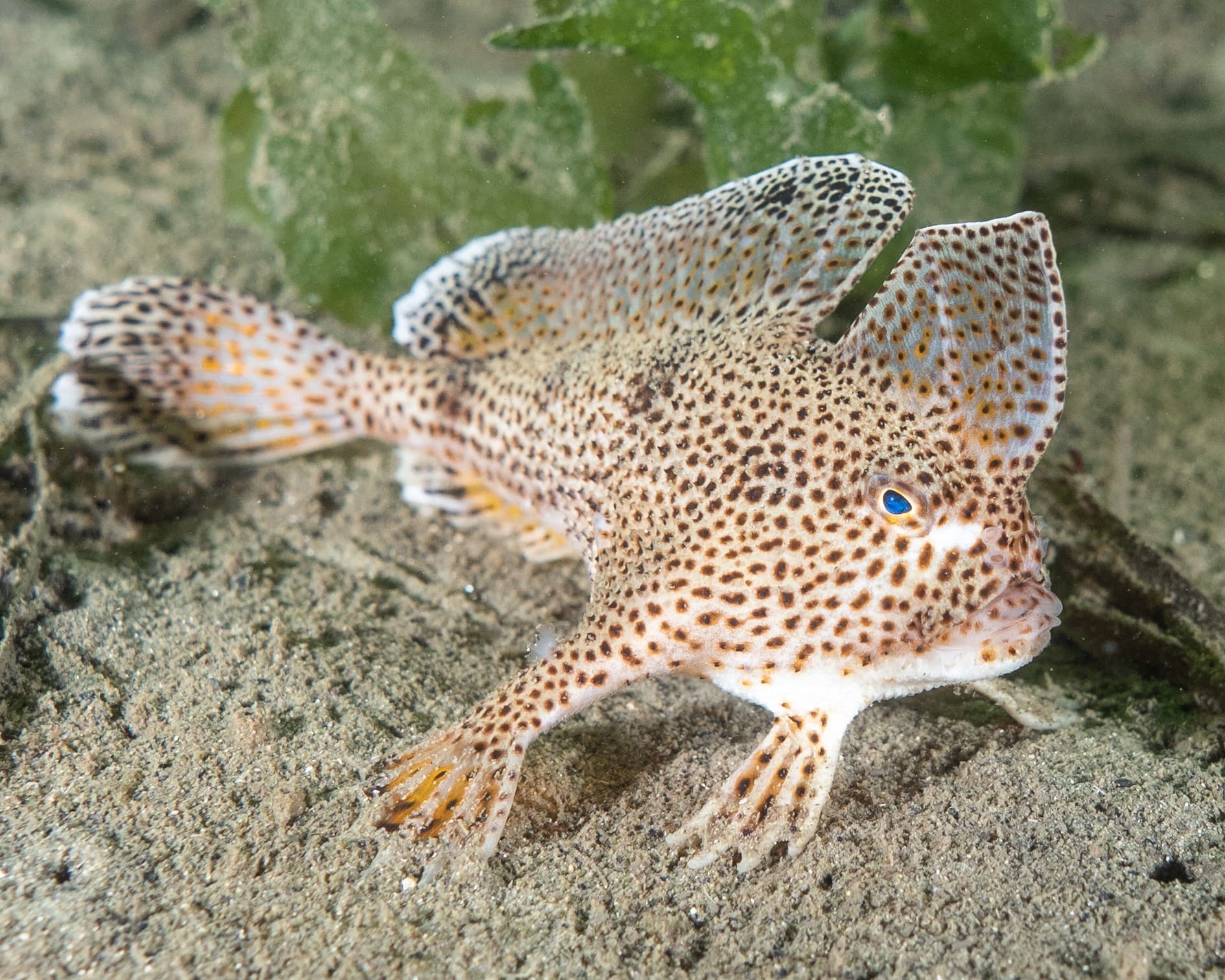
- There is evidence of marine biodiversity decline - read about it here, here and here.
- Learn about the importance of marine biodiversity here
The fish featured on the Localised Species Extinction card in the game is a spotten handfish. The spotted handfish is endemic to Tasmania and is currently classified as critically endangered.
Ocean acidification
Increasing atmospheric carbon increases the amount of carbon which dissolves into the ocean at the surface, resulting in a change in the ocean’s pH. Between 1950 and 2020 the average pH of the ocean shifted from 8.15 to 8.0, meaning it has become more acidic. In more acidic waters, it becomes increasingly difficult for animals to grow their shells and carbonate skeletons.
Learn more
- NOAA provides a great overview of ocean acidification on their website
- The Nature Education Knowledge Project also has a detailed explanation of the chemistry behind ocean acidification here

Left: A heteropod (zooplanktonic gastropod mollusc) collected off eastern Australia during a planktonic trawl on the RV Investigator. Heteropods are considered particularly vulnerable to ocean acidification due to their aragonite shells, which are particularly sensitive to dissolving. Centre: Sea urchin spines, gastropod and bivavle mollusc shells as seen through a dissecting microscope, all subject to negative impacts of ocean acidification. Right: Shells of a polyplacophoran (chiton) as seen through a dissecting microscope. Photos: A.R. Coghlan.
Plankton swarm occurs
Both phytoplankton (tiny plants) and the zooplankton (tiny animals) that feed on them are key steps in the food chain of many fish, shellfish, and other marine animals. Like plants, phytoplankton (which are usually microalgae) use sunlight to power chemical reactions that enable them to utilise resources in their environment and grow. This tiny little packages of nutrients are then predated upon by slightly larger (but still small) animals called zooplankton, and eventually fish.
The availability of key resources in the environment, mainly nutrients such as iron, is what limits phytoplankton growth. When sudden inputs of these nutrients become available, often the phytoplankton have everything else they need to survive and flourish - sometimes to the extent that phytoplankton blooms cause problems for humans (such as red tides).
Learn more
- Learn about phytoplankton from the Australian museum here.
- Check out this article about how a warming climate will affect zooplankton.
Plankton are tiny plants that bloom under ideal conditions, and are the first step in a food chain from sunlight to fish. Click on the picture to zoom in - the animals are tiny! Photo: A.R. Coghlan.
Seaweed planting occurs
Planting of seaweeds in habitats that used to contain healthy seaweed populations but have been degraded or damaged can be hugely beneficial. This is because seaweed can act as both a food source and habitat for many fish species across many stages of their life. Therefore, a healthy seaweed ecosystem restored into the correct habitat will help return and maintain healthy fish stocks.
How to play
Place a Seaweed or Giant Kelp card from your hand into your fishing spot.
Learn more
- Planting programs are currently working to restore giant kelp along Tasmania’s coasts
- Seaweed aquaculture (farming) can also be used as a conservation tool. Seaweed farms improve water quality, can act as nurseries for juvenile fish, and could potentially be used to soak up specific pollutants like heavy metals.
- Check out this Conversation article for more information about the potential benefits of seaweed farming.
Fisheries impose upper size limit
Large, old fish often produce disproportionately large numbers of offspring compared to fish of smaller sizes. Larger fish therefore contribute more to the next generation of fish which can be harvested. Protecting large ‘mega-spawners’ results in a greater yield of future fish. A 80 cm snapper produces ~24 times the offspring of a 40 cm snapper (but they both taste just as good!) and releasing the larger fish means more fish next year. In addition to producing disproportionately more young, large fish also connect different populations of fish – ensuring a rich and diverse gene-pool for tackling disease outbreaks and adapting to new conditions. Not all fish are made equal – big fish are more important to fish conservation into the future.
Learn more
- Learn why big snapper produce more offspring here
- Learn about the plan to Save the Red Snapper
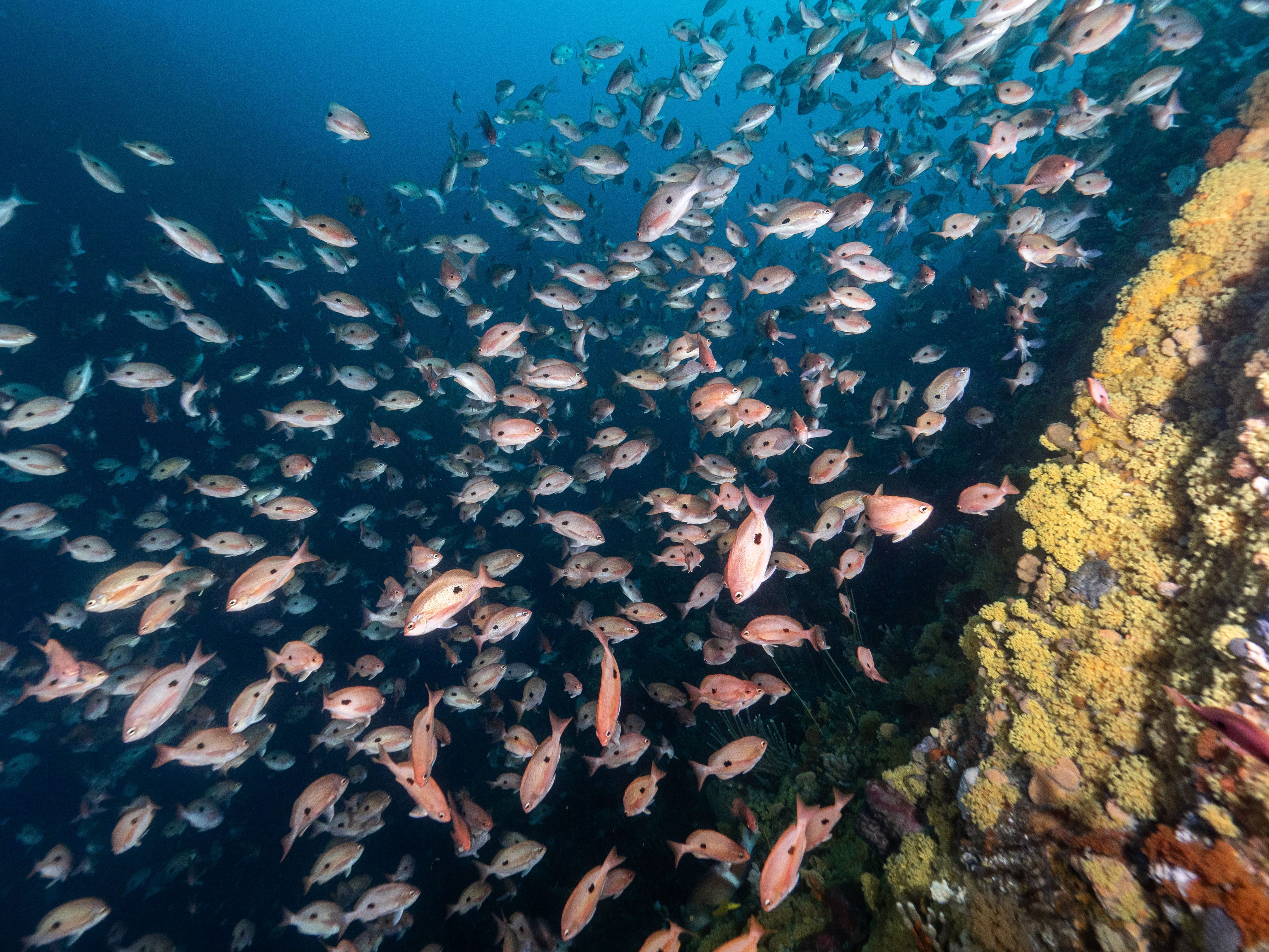
Long spined sea urchins arrive
Long Spined Sea Urchins have arrived in Tasmania as a range shifting specie due to warming waters induced by climate change. These urchins have been creating vast barrens on the seafloor over the last few decades. Barrens are areas that have been grazed by urchins and often consist of nothing but barren rock. This means that the habitat for many scale fish have been degraded and destroyed. Barrens can often be prevented by having an abundant number of adults marine species such as lobsters and gropers along with a commercial urchin fishery.
How to play
Each player must discard all Seaweed and Giant Kelp cards from their fishing spot.
Learn more
Long-spined urchins have been particularly devastating to Tasmania’s giant kelp forests, but efforts are underway to fight back.
- Check out this page put together by the Great Southern Reef Foundation about why long-spined urchins are such a problem, or the long-spined urchin project put together by the natural resource management organisation NRM South
- One way to eradicate long-spined urchins is to “eat the problem” with an urchin fishery. IMAS puts togehter fisheries assessments for many different marine species, including urchins.
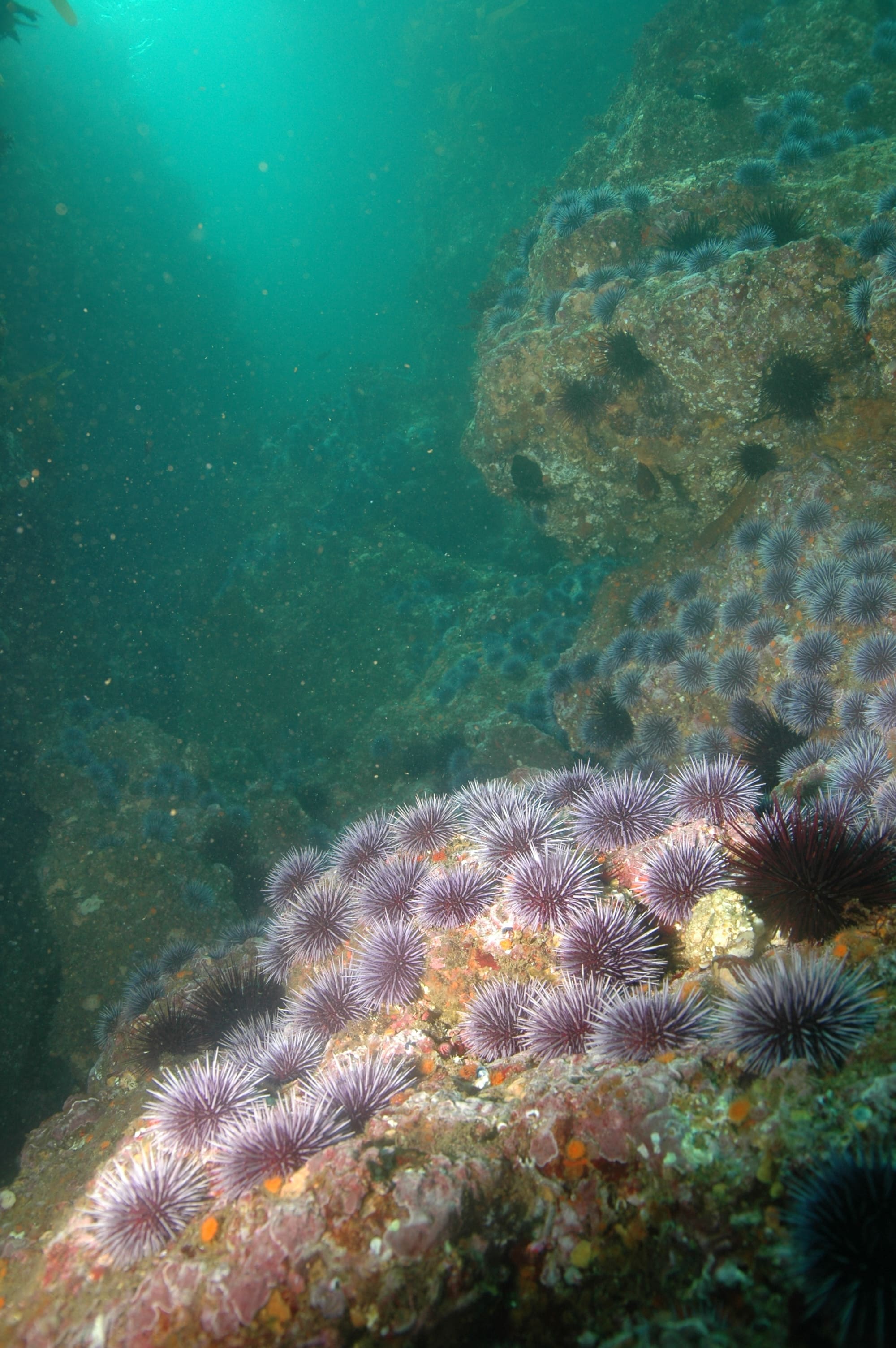
Invasive or overabundant urchins can quickly strip a reef of all seaweed and algae, creating an “urchin barren”.
